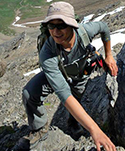PROPS alumni
Professor Boswell Wing
now at UC Boulder
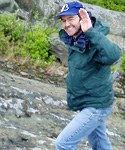 Earth system processes leave behind a geochemical 'memory' of their operation. In order to constrain the presence and vigor of these processes in the recent and ancient past, my research exploits the persistence of this memory in solid Earth archives and the unique ability of stable isotope measurements to recover it. Current research projects fall under two broad questions: (1) how can we maximize the gain on the geochemical signal of biological evolution preserved in the geologic record; and (2) how can we quantify the geochemical processes that determine whether an ore deposit forms or not? The peculiarity of the Precambrian environment is the thread tying both these questions together. This research is, at its root, hypothesis-based. Once a stimulating hypothesis is identified (often at one of our many group get-togethers), we design new field studies, analytical techniques, and laboratory experiments to test it. Note that Boz has relocated to the Department of Geological Sciences at the University of Colorado.
Earth system processes leave behind a geochemical 'memory' of their operation. In order to constrain the presence and vigor of these processes in the recent and ancient past, my research exploits the persistence of this memory in solid Earth archives and the unique ability of stable isotope measurements to recover it. Current research projects fall under two broad questions: (1) how can we maximize the gain on the geochemical signal of biological evolution preserved in the geologic record; and (2) how can we quantify the geochemical processes that determine whether an ore deposit forms or not? The peculiarity of the Precambrian environment is the thread tying both these questions together. This research is, at its root, hypothesis-based. Once a stimulating hypothesis is identified (often at one of our many group get-togethers), we design new field studies, analytical techniques, and laboratory experiments to test it. Note that Boz has relocated to the Department of Geological Sciences at the University of Colorado.
Dr Clint Scott (Post-doc, 2010–2012)
Currently at the USGS (Reston)
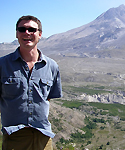 I study Archean and Proterozoic biogeochemical cycles. My primary target is organic carbon-rich black shales where we find C and N that was fixed by primary producers in the photic zone, reduced S (in the form of pyrite) whose isotopic composition speaks to the oxidation state of Earth’s atmosphere and enrichments, or lack thereof, of transition metals such as Fe, Mo, Cu and Zn that are required for vital cellular functions and are easily stripped from seawater under sulfidic conditions. The big picture questions that motivate my work are: 1) how did life on Earth and seawater chemistry co-evolve throughout Earth’s history, and 2) how and when did Earth’s atmosphere and oceans become oxygenated? Since the best record of life on the Precambrian Earth are biogeochemical signatures left behind by microbial life, we can think of black shales as biogeochemical Lagerstätten, with unmatched potential to reveal the oldest and best kept secrets of life on Earth.
I study Archean and Proterozoic biogeochemical cycles. My primary target is organic carbon-rich black shales where we find C and N that was fixed by primary producers in the photic zone, reduced S (in the form of pyrite) whose isotopic composition speaks to the oxidation state of Earth’s atmosphere and enrichments, or lack thereof, of transition metals such as Fe, Mo, Cu and Zn that are required for vital cellular functions and are easily stripped from seawater under sulfidic conditions. The big picture questions that motivate my work are: 1) how did life on Earth and seawater chemistry co-evolve throughout Earth’s history, and 2) how and when did Earth’s atmosphere and oceans become oxygenated? Since the best record of life on the Precambrian Earth are biogeochemical signatures left behind by microbial life, we can think of black shales as biogeochemical Lagerstätten, with unmatched potential to reveal the oldest and best kept secrets of life on Earth.
Dr Pierre Sansjofre (Post-doc, 2013)
Maitre de Conference, Museum National de l'Histoire Naturelle, Paris
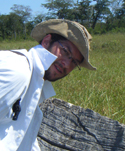 I study Precambrian oceans chemistry and try to understand its link with evolution of life. My focus is on the Neoproterozoic Era, when progressive oxygenation of Earth’s environment paved the way for animals. However the timing and pace of this oxidation event is unresolved. My research involves a combination of elemental and stable isotopic techniques (include trace metals, iron speciation, and C, S, N, and Feisotopes) to determine the redox state of both the water-column and sediments based on studies of rocks from various basins across the globe.
I study Precambrian oceans chemistry and try to understand its link with evolution of life. My focus is on the Neoproterozoic Era, when progressive oxygenation of Earth’s environment paved the way for animals. However the timing and pace of this oxidation event is unresolved. My research involves a combination of elemental and stable isotopic techniques (include trace metals, iron speciation, and C, S, N, and Feisotopes) to determine the redox state of both the water-column and sediments based on studies of rocks from various basins across the globe.
Dr. Maxwell Lechte (Post-doc, 2019–2024)
Post-doctoral Fellow, University of Melbourne
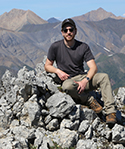
I study the sedimentology and geochemistry of marine sedimentary rocks in order to reconstruct Precambrian environmental conditions during key evolutionary events, in order to better understand the drivers and consequences of eukaryotic evolution. My research focuses on the biogeochemical cycling of iron: the distribution of sedimentary iron is a proxy for the evolution of the Earth’s surface redox conditions, and iron-rich chemical sediments can capture the chemistry of their contemporaneous seawater. Iron-rich marine sedimentary rocks from the early Neoproterozoic (potentially coincident with the first animal life) are well-preserved in the sedimentary basins of Yukon, and offer insights into the relationship between ocean chemistry, oxygenation and ecosystem complexity. More about my research can be found on my personal page at maxlechte.com.
Dr. Katie Maloney (Post-doc, 2022–2024)
Post-doctoral Fellow, Royal Ontario Museum

My research focuses on the co-evolution of the biosphere and geosphere. I use field-based, paleoenvironmental analysis to investigate: (1) the diversification and evolution of early eukaryotes; (2) the paleobiology and paleoecology of the Ediacaran Biota, the first known, large complex life; and (3) ecosystem reconstruction of critical transitions in Earth’s history. I am particularly interested in the macroalgae (e.g., seaweed) and their role in transforming seafloor environments and altering ocean geochemistry, setting the stage for the rise of more complex life. Learn more about my research at katiemmaloney.com
Dr. Joshua Zimmt (Post-doc, 2023–2024)
Post-doctoral Fellow, University of Tennessee
Dr Lei Wu (Post-doc, 2020–2022)

I study global tectonic history and have a particular interest in the dynamic evolution of the surface plate topology for the past two billion years. I work with a variety of geological and geophysical databases, including paleomagnetic, seismological and paleoclimatic data. To better understand those datasets, I explore and employ new analytical methods to gain insights into first-order changes in Earth’s tectonic history. Within interdisciplinary teams, I have led several projects on addressing major tectonic problems, namely dispersion of East Gondwana, the assembly of East Asia and its thermal legacy for the underlying mantle, the formation of Pangea, and tectonic imprints on the Cordilleran Laurentia. Collectively, my research aims to answer the fundamental question on how plate tectonics have shaped Earth’s mantle circulation, climate changes and life evolution.
Dr. Morgann Perrot
Research Associate

I study global tectonic history and have a particular interest in the dynamic evolution of the surface plate topology for the past two billion years. I work with a variety of geological and geophysical databases, including paleomagnetic, seismological and paleoclimatic data. To better understand those datasets, I explore and employ new analytical methods to gain insights into first-order changes in Earth’s tectonic history. Within interdisciplinary teams, I have led several projects on addressing major tectonic problems, namely dispersion of East Gondwana, the assembly of East Asia and its thermal legacy for the underlying mantle, the formation of Pangea, and tectonic imprints on the Cordilleran Laurentia. Collectively, my research aims to answer the fundamental question on how plate tectonics have shaped Earth’s mantle circulation, climate changes and life evolution.
Pascale Daoust (PhD, 2024)
Research Director, Anticosti Island World Heritage Project
 Carbonate rocks and sediments are an important component of the Earth system, in particular in the context of ocean acidification. Therefore, ancient and modern carbonates can provide insights on both the effects of modern climate change and past paleoclimatic perturbations. The objective of my PhD research is to simulate the progressive impact of ocean acidification on the mineralogy of modern platform carbonate sediments and compare the results with the mineralogy of ancient carbonates from key greenhouse periods in Earth's history.
Carbonate rocks and sediments are an important component of the Earth system, in particular in the context of ocean acidification. Therefore, ancient and modern carbonates can provide insights on both the effects of modern climate change and past paleoclimatic perturbations. The objective of my PhD research is to simulate the progressive impact of ocean acidification on the mineralogy of modern platform carbonate sediments and compare the results with the mineralogy of ancient carbonates from key greenhouse periods in Earth's history.
Wilder Greenman (PhD 2022)
Post-doc, Dalhousie University
 I investigate the ecological niches where the first complex organisms on Earth would have evolved during the Proterozoic. This detailed work requires a combination of sedimentology, micropalaeontology and isotope geochemistry to reconstruct these ancient environments. To understand the evolution of the basins where these events took place, I employ tools such as sequence stratigraphy, chemostratigraphy, and geochronology. Fieldwork for my PhD project will take place mainly on the late Mesoproterozoic Bylot basins of Baffin Island. I aim to answer questions about the interplay between the evolution of complex microorganisms, climatic shifts and biogeochemical change.
I investigate the ecological niches where the first complex organisms on Earth would have evolved during the Proterozoic. This detailed work requires a combination of sedimentology, micropalaeontology and isotope geochemistry to reconstruct these ancient environments. To understand the evolution of the basins where these events took place, I employ tools such as sequence stratigraphy, chemostratigraphy, and geochronology. Fieldwork for my PhD project will take place mainly on the late Mesoproterozoic Bylot basins of Baffin Island. I aim to answer questions about the interplay between the evolution of complex microorganisms, climatic shifts and biogeochemical change.
Chen Shen (PhD 2021)
Researcher, Beijing Petroleum Institute
 An accurate geological time scale is required to properly reconstruct the evolution of the Earth system during the Neoproterozoic (1000-539 million years ago) interval in Earth’s history. The increased application of the U-Pb zircon and Re-Os radiometric techniques have effectively improved geochronological constraints for the Proterozoic Eon. My research focuses on developing and applying new methodologies for calibrating the Neoproterozoic geological time scale using Bayesian statistical modelling and cyclostratigraphy, using available radiometric ages and other chronostratigraphic tie points, which will produce a highly resolved and correlative time scale for a poorly understood interval in Earth’s history that overlaps with the first appearance of animals.
An accurate geological time scale is required to properly reconstruct the evolution of the Earth system during the Neoproterozoic (1000-539 million years ago) interval in Earth’s history. The increased application of the U-Pb zircon and Re-Os radiometric techniques have effectively improved geochronological constraints for the Proterozoic Eon. My research focuses on developing and applying new methodologies for calibrating the Neoproterozoic geological time scale using Bayesian statistical modelling and cyclostratigraphy, using available radiometric ages and other chronostratigraphic tie points, which will produce a highly resolved and correlative time scale for a poorly understood interval in Earth’s history that overlaps with the first appearance of animals.
Sarah Wörndle (PhD 2019)
Professor at John Abott College
 Earth's redox system has evolved over Earth's history, but quantifying this change in the Precambrian is challenging. My research focuses on global changes to Earth's environment across the Mesoproterozoic-Neoproterozoic transition. The goal of my PhD project is develop new and better calibrated records of redox and seawater chemistry spanning this transition and to relate these changes to eukaryotic evolution, the assembly of Rodinia, and other first-order geological events.
Earth's redox system has evolved over Earth's history, but quantifying this change in the Precambrian is challenging. My research focuses on global changes to Earth's environment across the Mesoproterozoic-Neoproterozoic transition. The goal of my PhD project is develop new and better calibrated records of redox and seawater chemistry spanning this transition and to relate these changes to eukaryotic evolution, the assembly of Rodinia, and other first-order geological events.
Timothy Gibson (PhD 2018)
Currently an NSF Post-doc at Yale University
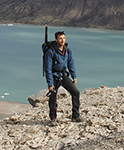 My research utilizes various late Mesoproterozoic to early Neoproterozoic (ca. 1200–800 Ma) sedimentary successions in arctic Canada as natural laboratories to investigate connections between Earth’s tectonic, geochemical, and biological histories. This work begins out in the field, where a robust depositional framework is constructed by integrating mapping, sedimentology, and sequence stratigraphy, and is highly collaborative in nature – I work with other field geologists and geochemists, as well as paleontologists and biologists. Because timing, correlation, and rates of change are essential for deciphering these ancient stories, I implement U-Pb and Re-Os geochronology wherever possible to obtain absolute ages. I also analyze various radiogenic isotopes (Sr, Nd, Os) in these ancient strata to characterize the influence of chemical weathering on basin water chemistry to elucidate how tectonics affect Earth’s biological and geochemical evolution through silicate weathering and the supply of nutrients to the ocean. Ultimately, these data will help characterize the tectonic evolution of northern Laurentia, as well as the roles various global tectonic regimes throughout Rodinia’s lifespan played leading up to perturbations to the carbon cycle later in the Neoproterozoic Era.
My research utilizes various late Mesoproterozoic to early Neoproterozoic (ca. 1200–800 Ma) sedimentary successions in arctic Canada as natural laboratories to investigate connections between Earth’s tectonic, geochemical, and biological histories. This work begins out in the field, where a robust depositional framework is constructed by integrating mapping, sedimentology, and sequence stratigraphy, and is highly collaborative in nature – I work with other field geologists and geochemists, as well as paleontologists and biologists. Because timing, correlation, and rates of change are essential for deciphering these ancient stories, I implement U-Pb and Re-Os geochronology wherever possible to obtain absolute ages. I also analyze various radiogenic isotopes (Sr, Nd, Os) in these ancient strata to characterize the influence of chemical weathering on basin water chemistry to elucidate how tectonics affect Earth’s biological and geochemical evolution through silicate weathering and the supply of nutrients to the ocean. Ultimately, these data will help characterize the tectonic evolution of northern Laurentia, as well as the roles various global tectonic regimes throughout Rodinia’s lifespan played leading up to perturbations to the carbon cycle later in the Neoproterozoic Era.
Peter Crockford (PhD 2017)
Post-doc, Woods Hole Oceanographic Institute; Assistant Professor Carleton University
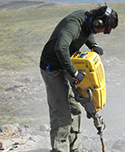 The majority of the Proterozoic eon has been touted as “The Boring Billion” due to apparent stasis in the Earth System, however advances in spectrometry are now allowing geochemists to gain far more insight from the geologic record. My interests lie in using a combination of field geology and a variety of isotopic analyses to measure paleo-environmental proxies throughout the Proterozoic eon, a period in my opinion ripe for re-examination. Part of my work will include field campaigns to the Borden Basin on Baffin Island (Nu) and the Mackenzie Mountains (NWT) to collect samples and perform some geologic mapping of well exposed sedimentary packages. The overarching goal of this work is to both test and develop paleo-oceanographic and atmospheric models over this time period using real data collected from well-preserved sections.
The majority of the Proterozoic eon has been touted as “The Boring Billion” due to apparent stasis in the Earth System, however advances in spectrometry are now allowing geochemists to gain far more insight from the geologic record. My interests lie in using a combination of field geology and a variety of isotopic analyses to measure paleo-environmental proxies throughout the Proterozoic eon, a period in my opinion ripe for re-examination. Part of my work will include field campaigns to the Borden Basin on Baffin Island (Nu) and the Mackenzie Mountains (NWT) to collect samples and perform some geologic mapping of well exposed sedimentary packages. The overarching goal of this work is to both test and develop paleo-oceanographic and atmospheric models over this time period using real data collected from well-preserved sections.
Jesse Colangelo-Lillis (PhD 2016)
Currently a post-doc at the University of Colorado
 Microbial evolution over three billion years has allowed Bacteria and Archaea to invade environments characterized by disparate regimes of temperature, redox potential, and geochemistry. I am interested in exploring the mechanisms of microbial evolution and evidence for the state of those processes in the past, in particular as these relate to the field of Astrobiology. This manifests in projects exploring the diversity of sulfur metabolic genes and their relationship to phylogeny (bioinformatics); measuring the fractionation of sulfur isotopes by sulfur-metabolizing Bacteria cultures under various simulated environmental conditions (laboratory work); and assessing the abundance, distribution and metabolism of sulfur-metabolizing microbes in cold environments (field work).
Microbial evolution over three billion years has allowed Bacteria and Archaea to invade environments characterized by disparate regimes of temperature, redox potential, and geochemistry. I am interested in exploring the mechanisms of microbial evolution and evidence for the state of those processes in the past, in particular as these relate to the field of Astrobiology. This manifests in projects exploring the diversity of sulfur metabolic genes and their relationship to phylogeny (bioinformatics); measuring the fractionation of sulfur isotopes by sulfur-metabolizing Bacteria cultures under various simulated environmental conditions (laboratory work); and assessing the abundance, distribution and metabolism of sulfur-metabolizing microbes in cold environments (field work).
Dr. Marcus Kunzmann (PhD 2016)
Senior Geologist, Fortescue Metals Group
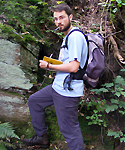 In order to understand the evolution of the Paleoproterozoic and Neoproterzoic atmosphere, biosphere, and depositional environments and their interaction with changing seawater chemistry and tectonics, I combine detailed geological field studies of sedimentary rocks (e.g., NW Canada, South Australia, South Africa) with geochemical investigations. The geochemical proxies of my choice include traditional light stable isotopes (C, O) and, in particular, non-traditional stable isotopes like Zn. These novel isotope proxies have great potential to tell us how ocean redox and primary productivity evolved in the Precambrian and offer an opportunity to obtain more information on the formation of sedimentary rocks and paleoenvironmental changes. (Go to Marcus' personal webpage)
In order to understand the evolution of the Paleoproterozoic and Neoproterzoic atmosphere, biosphere, and depositional environments and their interaction with changing seawater chemistry and tectonics, I combine detailed geological field studies of sedimentary rocks (e.g., NW Canada, South Australia, South Africa) with geochemical investigations. The geochemical proxies of my choice include traditional light stable isotopes (C, O) and, in particular, non-traditional stable isotopes like Zn. These novel isotope proxies have great potential to tell us how ocean redox and primary productivity evolved in the Precambrian and offer an opportunity to obtain more information on the formation of sedimentary rocks and paleoenvironmental changes. (Go to Marcus' personal webpage)
Dr. Grant Cox (PhD 2015)
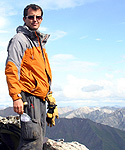 My interests revolve around the geochemistry of igneous and sedimentary rocks and what geochemistry can tell us about modes of formation and tectonic settings. The geochemistry utilised as a part of this work includes traditional major and trace element analysis as well as stable and radiogenic isotopes. This work often involves an "attempt" to better constrain time and so I am involved in the dating of igneous rocks via TIMS, LA-ICP-MS and isochron methods. Generally my work focuses on rocks that are Neoproterozic in age and my field areas include the Yukon Territories, Canada, the Arabian Nubian Shield, Saudi Arabia, and the Flinders Ranges, South Australia. The broader focus of this work involves exploring the relationship between extreme climate change (i.e., Snowball Earth) and tectonic evolution (i.e., the breakup of Rodinia and the formation of Gondwana).
My interests revolve around the geochemistry of igneous and sedimentary rocks and what geochemistry can tell us about modes of formation and tectonic settings. The geochemistry utilised as a part of this work includes traditional major and trace element analysis as well as stable and radiogenic isotopes. This work often involves an "attempt" to better constrain time and so I am involved in the dating of igneous rocks via TIMS, LA-ICP-MS and isochron methods. Generally my work focuses on rocks that are Neoproterozic in age and my field areas include the Yukon Territories, Canada, the Arabian Nubian Shield, Saudi Arabia, and the Flinders Ranges, South Australia. The broader focus of this work involves exploring the relationship between extreme climate change (i.e., Snowball Earth) and tectonic evolution (i.e., the breakup of Rodinia and the formation of Gondwana).
Dr. André Pellerin (PhD 2014)
Assistant Professor, Université du Québec à Rimouski
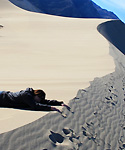 Sulfate reducing microorganisms (SRM) have been around for quite some time. Geological evidence has it pretty well constrained that they are old. What did the first SRM look like and more importantly how did it behave? Does three and a half billion years have an effect on the SRM metabolism? I’m trying to figure out if the geological record is a good proxy for reconstructing early Earth environments by investigating whether the products of evolution we are seeing today (modern SRM) have the same effect on the environment as their ancestors, which lived on a younger and environmentally very different planet!
Sulfate reducing microorganisms (SRM) have been around for quite some time. Geological evidence has it pretty well constrained that they are old. What did the first SRM look like and more importantly how did it behave? Does three and a half billion years have an effect on the SRM metabolism? I’m trying to figure out if the geological record is a good proxy for reconstructing early Earth environments by investigating whether the products of evolution we are seeing today (modern SRM) have the same effect on the environment as their ancestors, which lived on a younger and environmentally very different planet!
Lucie Hubert-Théou
 My project involves coupling general circulation, silicate weathering, and biogeochemical models to better understand Neoproterozoic climate change and ocean chemistry. Through modeling I wish to develop innovative ways of testing contentious hypotheses such as true polar wander and the effect of emplacement and weathering of basaltic provinces on the initiation of global glaciation. At the same time, this project will establish criteria for identifying the influence of these events in the chemostratigraphic record. This work will combine up-to-date paleogeographies, geological constraints, modeling, and isotope geochemistry and constitutes an innovative approach compared to previous monodisciplinary efforts to understand ancient paleoclimates.
My project involves coupling general circulation, silicate weathering, and biogeochemical models to better understand Neoproterozoic climate change and ocean chemistry. Through modeling I wish to develop innovative ways of testing contentious hypotheses such as true polar wander and the effect of emplacement and weathering of basaltic provinces on the initiation of global glaciation. At the same time, this project will establish criteria for identifying the influence of these events in the chemostratigraphic record. This work will combine up-to-date paleogeographies, geological constraints, modeling, and isotope geochemistry and constitutes an innovative approach compared to previous monodisciplinary efforts to understand ancient paleoclimates.
Maggie Whelan (MSc 2023)
Geologist, IAMGOLD Inc.
William Wong (MSc 2022)
Teegan Ojala
MSc student (2018–2020), Earth and Planetary Sciences
Kelsey Lamothe (MSc 2018)
PhD student at the University of Melbourne
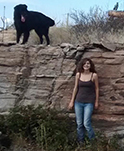
Ying Ran Lin (MSc 2017)
Malcolm Hodgskiss (BSc honours, 2015; MSc 2016)
Geological Survey of Nrway
 I’m interested in the apparent environmental stability of the late Paleoproterozoic and Mesoproterozoic. Despite recording the growth and break-up of Nuna, the probable first appearance of eukaryotes, and the final major pulse of BIF deposition, this relatively poorly studied interval has been termed the “boring billion”. Through a combination of fieldwork and geochemistry, I plan to investigate how “boring” this time actually was.
I’m interested in the apparent environmental stability of the late Paleoproterozoic and Mesoproterozoic. Despite recording the growth and break-up of Nuna, the probable first appearance of eukaryotes, and the final major pulse of BIF deposition, this relatively poorly studied interval has been termed the “boring billion”. Through a combination of fieldwork and geochemistry, I plan to investigate how “boring” this time actually was.
Emma Bertran (MSc 2013)
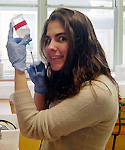 Sulfate reducing bacteria are important actors in the sulfur, carbon, and oxygen cycles. Their highly tuned metabolism produces characteristic isotopic fractionations evident in waste products (e.g., H2S) and in the metabolic substrates they utilize (e.g., SO42-). These sulfur isotopic signatures are then preserved in the rock record (eg., in grains of pyrite) as the fingerprint of microbial activity. The primary objective of my research project is to use experimental evolution in order to reveal the rate of change of microbial metabolism under specific stressors and the consequent impacts on sulphur isotopic fractionation using Desulfovibrio vulgaris as the experimental subject.
Sulfate reducing bacteria are important actors in the sulfur, carbon, and oxygen cycles. Their highly tuned metabolism produces characteristic isotopic fractionations evident in waste products (e.g., H2S) and in the metabolic substrates they utilize (e.g., SO42-). These sulfur isotopic signatures are then preserved in the rock record (eg., in grains of pyrite) as the fingerprint of microbial activity. The primary objective of my research project is to use experimental evolution in order to reveal the rate of change of microbial metabolism under specific stressors and the consequent impacts on sulphur isotopic fractionation using Desulfovibrio vulgaris as the experimental subject.
Kristyn Rodzinyak (MSc 2013)
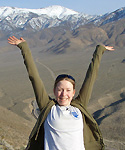 My research focuses on using sulfur isotopes ratios found in rock samples to study Earth’s past atmosphere and also as a method for understanding conditions on other planets. In one project I am using sulfur isotopes as a proxy for atmospheric oxygen, specifically by working on the relationship between rock type and sulfur isotope signal in the Mesoarchaean (2.7-3.0 billion years ago). Stable isotopes ratios of sulfur in the Archaean cannot be predicted solely based on mass differences between isotopes (32S, 33S, 34S and 36S). Throughout the Archaean these differences from the predicted values of mass differences (termed Δ33S) have variable magnitude and I’m interested in exploring or confirming why this variability decreases in the Mesoarchaean. Is this due to a sampling bias or an atmospheric signal (i.e., changes in volcanic gases, increased oxygen, organic methane haze)? My field area for this project involves several Greenstone belts in Northwestern Ontario where clastic and chemical sedimentary rocks can be compared to the existing sample base. I also use sulfur isotopes to look at pyrite oxidation in nodules from Devon Island in the Canadian Arctic as a Mars analogue site for iron and sulfur minerals that have been identified by the Mars Exploration Rover Opportunity.
My research focuses on using sulfur isotopes ratios found in rock samples to study Earth’s past atmosphere and also as a method for understanding conditions on other planets. In one project I am using sulfur isotopes as a proxy for atmospheric oxygen, specifically by working on the relationship between rock type and sulfur isotope signal in the Mesoarchaean (2.7-3.0 billion years ago). Stable isotopes ratios of sulfur in the Archaean cannot be predicted solely based on mass differences between isotopes (32S, 33S, 34S and 36S). Throughout the Archaean these differences from the predicted values of mass differences (termed Δ33S) have variable magnitude and I’m interested in exploring or confirming why this variability decreases in the Mesoarchaean. Is this due to a sampling bias or an atmospheric signal (i.e., changes in volcanic gases, increased oxygen, organic methane haze)? My field area for this project involves several Greenstone belts in Northwestern Ontario where clastic and chemical sedimentary rocks can be compared to the existing sample base. I also use sulfur isotopes to look at pyrite oxidation in nodules from Devon Island in the Canadian Arctic as a Mars analogue site for iron and sulfur minerals that have been identified by the Mars Exploration Rover Opportunity.
Matthew Hryciuk (MSc 2013)
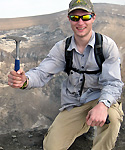 My principal research interests are large igneous provinces and orthomagmatic ore deposits. For my Master's Thesis, I am studying the Neoproterozoic Franklin sills on Victoria Island in the western Canadian Arctic. I am using sulphur isotopes to evaluate the interactions between intrusions and their host sedimentary rocks including processes such as upper crustal assimilation, fractional crystallization, diffusive transport, degassing and hydrothermal effects. I am originally from Edmonton, Alberta, and did my undergraduate degree in geology at the University of Alberta. My favourite part of geology is doing field work because it is a great way to see parts of the world that you normally wouldn't and I enjoy trying the problem solving aspect of it.
My principal research interests are large igneous provinces and orthomagmatic ore deposits. For my Master's Thesis, I am studying the Neoproterozoic Franklin sills on Victoria Island in the western Canadian Arctic. I am using sulphur isotopes to evaluate the interactions between intrusions and their host sedimentary rocks including processes such as upper crustal assimilation, fractional crystallization, diffusive transport, degassing and hydrothermal effects. I am originally from Edmonton, Alberta, and did my undergraduate degree in geology at the University of Alberta. My favourite part of geology is doing field work because it is a great way to see parts of the world that you normally wouldn't and I enjoy trying the problem solving aspect of it.
Thomas Maguire
 I love being outside in mountains and can't stop thinking scientifically about big questions. Hence a career in geology and geochemistry. During the Neoproterozoic and Cambrian, the Earth was undergoing dramatic, interrelated changes, not the least of which being the evolution of metazoans and an oxygen rich atmosphere. My research is focussed on understanding these rock-recorded changes in a palaeo-oceanographic context. I plan to apply a variety of tools are used to accomplish this, including stable isotope geochemistry, sedimentology, mineralogy and modelling. My nerdthusiasm is contagious, so beware.
I love being outside in mountains and can't stop thinking scientifically about big questions. Hence a career in geology and geochemistry. During the Neoproterozoic and Cambrian, the Earth was undergoing dramatic, interrelated changes, not the least of which being the evolution of metazoans and an oxygen rich atmosphere. My research is focussed on understanding these rock-recorded changes in a palaeo-oceanographic context. I plan to apply a variety of tools are used to accomplish this, including stable isotope geochemistry, sedimentology, mineralogy and modelling. My nerdthusiasm is contagious, so beware.
Mônica Mendes
Visiting PhD Student (from UFMG, Brazil)
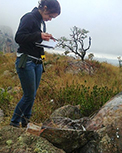 The Quadrilátero Ferrífero Mining District (Iron Quadrangle), located in Minas Gerais, Brazil, contains some of the largest iron ore deposits if the world. The hydrothermal iron ore, hosted in Precambrian iron formations of different mineralogical composition, show a significant microstructural and textural variation throughout the region, due to the variation of deformational intensity and metamorphic grade. My research is focused on the investigation of the occurrence of iron isotope fractionation, as a result of the hydrothermal mineralization.
The Quadrilátero Ferrífero Mining District (Iron Quadrangle), located in Minas Gerais, Brazil, contains some of the largest iron ore deposits if the world. The hydrothermal iron ore, hosted in Precambrian iron formations of different mineralogical composition, show a significant microstructural and textural variation throughout the region, due to the variation of deformational intensity and metamorphic grade. My research is focused on the investigation of the occurrence of iron isotope fractionation, as a result of the hydrothermal mineralization.
Gabriel Uhlein
Visiting MSc student (2013) from Universidade Federal de Minas Gerais, Brazil; Currently Professor at UFMG
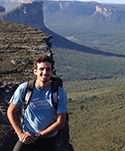 My research is on provenance of conglomeratic-siliciclastic units in Bambuí Group, São Francisco Craton (late Neoproterozoic of central-east Brazil). Using C, O and Sr isotopes on carbonate clasts, Nd model ages on fine-grained lithotypes and detrital zirconsl, I am trying to establish different provenance patterns for these units. Understanding the role of the conglomeratic units can certainly improve the knowledge on the evolution of the Bambuí Basin.
My research is on provenance of conglomeratic-siliciclastic units in Bambuí Group, São Francisco Craton (late Neoproterozoic of central-east Brazil). Using C, O and Sr isotopes on carbonate clasts, Nd model ages on fine-grained lithotypes and detrital zirconsl, I am trying to establish different provenance patterns for these units. Understanding the role of the conglomeratic units can certainly improve the knowledge on the evolution of the Bambuí Basin.
Dr. Fabrício Caxito
Visiting PhD student (2010–2012); Currently a professor at Universidade Federal de Minas Gerais (UFMG), Brazil
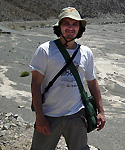 My research is aimed at the compared stratigraphy and tectonic evolution of Neoproterozoic cratonic and fold belt sequences in Brazil through careful geologic mapping, geochemistry and geochronology.
My research is aimed at the compared stratigraphy and tectonic evolution of Neoproterozoic cratonic and fold belt sequences in Brazil through careful geologic mapping, geochemistry and geochronology.
Hai-Feng Ding
Visiting PhD student (2010–2011)
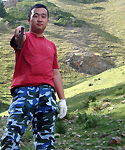 I am interested in paleoclimate change during the Neoproterzoic to early-Cambrian. Supported by the National Basic Research Program of China - Continental Dynamic Process and Metallogy of Centric Asian Orogenic Belt, my research focuses on the elements and isotope geochemistry of Neoproterozoic glaciogenic diamictite or tillite in Xinjiang, Northwest China. In Xinjiang, there are several pre-Cambrian microcontinents. I use geochemistry with geochronology, sedimentology and tectonics to research the Xinjiang microcontinents paleoenvironment correlation in geological history. I also attend the field work about the Neoproterozoic to early-Cambrian in South China, and make contradistinctive research between the Xinjiang and Yangtze plates.
I am interested in paleoclimate change during the Neoproterzoic to early-Cambrian. Supported by the National Basic Research Program of China - Continental Dynamic Process and Metallogy of Centric Asian Orogenic Belt, my research focuses on the elements and isotope geochemistry of Neoproterozoic glaciogenic diamictite or tillite in Xinjiang, Northwest China. In Xinjiang, there are several pre-Cambrian microcontinents. I use geochemistry with geochronology, sedimentology and tectonics to research the Xinjiang microcontinents paleoenvironment correlation in geological history. I also attend the field work about the Neoproterozoic to early-Cambrian in South China, and make contradistinctive research between the Xinjiang and Yangtze plates.
Dr. Eric Bellefroid
BSc (2013); PhD (Yale, 2018), McKinsey and Company
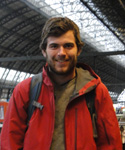 I am working on iron formation deposited in various parts of the world during Cryogenian (c. 720–635 Ma) glaciation. Geochemical data on these rocks, including iron isotope compositions and normalized trace element concentrations, reveal clues as to the source of iron in these rocks and the chemistry of the oceans during the snowball glaciations. One question I am addressing is whether or not these iron formations where all deposited during the same glaciation, hence recording a global phenomenon, or rather if they represent more regional phenomena.
I am working on iron formation deposited in various parts of the world during Cryogenian (c. 720–635 Ma) glaciation. Geochemical data on these rocks, including iron isotope compositions and normalized trace element concentrations, reveal clues as to the source of iron in these rocks and the chemistry of the oceans during the snowball glaciations. One question I am addressing is whether or not these iron formations where all deposited during the same glaciation, hence recording a global phenomenon, or rather if they represent more regional phenomena.
Kasparas Spokas
BSc (2014); PhD (Princeton, 2019), Clean Air Task Force
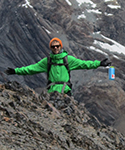 My research interests fall within the challenging task of establishing the timing of and the mechanism for the final Precambrian increase of environmental (seawater and the atmosphere) oxygen concentrations, to the levels permissive of early animal evolution. More specifically, my research will investigate the sulfur isotope system in the early Neoproterozoic, rather than the late Precambrian, to uncover a hypothesized earlier environmental oxygenation than previously thought.
My research interests fall within the challenging task of establishing the timing of and the mechanism for the final Precambrian increase of environmental (seawater and the atmosphere) oxygen concentrations, to the levels permissive of early animal evolution. More specifically, my research will investigate the sulfur isotope system in the early Neoproterozoic, rather than the late Precambrian, to uncover a hypothesized earlier environmental oxygenation than previously thought.
Léa Braschi (Climate Impact Scientist at CBCL Limited)
BSc student (2011)
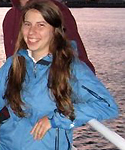 I am doing an undergraduate study to investigate whether Archean pillow basalts can be used as a paeoenvironmental record of the Archean sulfur cycle. Pillow basalts are of particular interest because we know that they occur at the bottom of the sea today, so we know that our samples represent the sea floor lithosphere-hydrosphere interface in the Archean. The Archean S cycle is of particular interest because multiple sulfur isotopes indicate a fully coupled S cycle among the Archean atmosphere, hydrosphere, biosphere and lithosphere. I am testing whether pillow basalts can preserve a paleoenvironmental signal by performing center-to-rim S isotope transects through single pillows. Our primary samples are from the Lumby Lake greenstone belt, Northern Ontario, which is ~2.9 Ga. These samples are also part of Kristyn Rodzinyak's masters project.
I am doing an undergraduate study to investigate whether Archean pillow basalts can be used as a paeoenvironmental record of the Archean sulfur cycle. Pillow basalts are of particular interest because we know that they occur at the bottom of the sea today, so we know that our samples represent the sea floor lithosphere-hydrosphere interface in the Archean. The Archean S cycle is of particular interest because multiple sulfur isotopes indicate a fully coupled S cycle among the Archean atmosphere, hydrosphere, biosphere and lithosphere. I am testing whether pillow basalts can preserve a paleoenvironmental signal by performing center-to-rim S isotope transects through single pillows. Our primary samples are from the Lumby Lake greenstone belt, Northern Ontario, which is ~2.9 Ga. These samples are also part of Kristyn Rodzinyak's masters project.
Ellen Leask
BSc/Honours student(2011); currently PhD student at Cal Tech
Geochemistry of black shales to understand coupled effects of redox changes in Proterozoic oceans and the influence of provenance.
Gilles Couturier
BSc (2012) student in Earth and Plantetary Sciences; recently completed his Master's at Concordia University
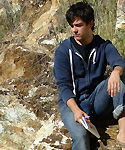 I am interested in using geological tools in order to extract past environmental information and data to understand past climate and to find possible analogues to future climate. Furthermore, I am also using hydrogeology to understand the effect of current environmental fluctuations on water discharge and glacier melt. I like to use geology as a tool to understand the workings of the environmental systems.
I am interested in using geological tools in order to extract past environmental information and data to understand past climate and to find possible analogues to future climate. Furthermore, I am also using hydrogeology to understand the effect of current environmental fluctuations on water discharge and glacier melt. I like to use geology as a tool to understand the workings of the environmental systems.
Andrei Popescu
BSc (2012) student; currently an exploration geologist at Encana (Calgary)
 I am a 3rd year of Earth Science student at McGill. I am working on a project based in the Ogilvie Mountains, Yukon Territory, to study how how seawater chemistry evolved around the time the supercontinent Rodinia began to break apart (~800 Million years ago). This summer I am working on a mapping project in Central Alberta for Encana Corporation.
I am a 3rd year of Earth Science student at McGill. I am working on a project based in the Ogilvie Mountains, Yukon Territory, to study how how seawater chemistry evolved around the time the supercontinent Rodinia began to break apart (~800 Million years ago). This summer I am working on a mapping project in Central Alberta for Encana Corporation.
John Prince
BSc (2012) student, Earth and Planetary Sciences
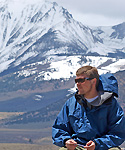 My interests lie in the fields of Sedimentology and Geochemistry. By conducting isotope chemostratigraphy on sedimentary sequences it is possible to estimate the size of the marine sulfate reservoir and to model the relative abundance of oxygen in the atmosphere for the time period. For the past two field seasons I have been working on Victoria Island, NWT, with the Geological Survey of Canada where I have conducted research for an undergraduate thesis project and have started work on a Masters project. The sedimentary sequences that I study are early Neoproterozoic in age and are thought to have been deposited during the break-up of the supercontinent Rhodinia and prior to a major global glaciation.
My interests lie in the fields of Sedimentology and Geochemistry. By conducting isotope chemostratigraphy on sedimentary sequences it is possible to estimate the size of the marine sulfate reservoir and to model the relative abundance of oxygen in the atmosphere for the time period. For the past two field seasons I have been working on Victoria Island, NWT, with the Geological Survey of Canada where I have conducted research for an undergraduate thesis project and have started work on a Masters project. The sedimentary sequences that I study are early Neoproterozoic in age and are thought to have been deposited during the break-up of the supercontinent Rhodinia and prior to a major global glaciation.
Michelle Vokaty
BSc (2014) student, Earth and Planetary Sciences
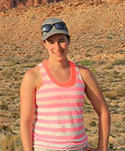 My research project involves careful analysis of shales from the Svalbard complex through neodymium isotope chemistry. From the εNd values, we will be able to establish the source of the rocks being from either weathered basaltic provinces or older sedimentary continental crust. This will allow us to understand the weathering patterns following the glaciation and other events during the Neoproterozoic and to test paleogeographic reconstructions at this time.
My research project involves careful analysis of shales from the Svalbard complex through neodymium isotope chemistry. From the εNd values, we will be able to establish the source of the rocks being from either weathered basaltic provinces or older sedimentary continental crust. This will allow us to understand the weathering patterns following the glaciation and other events during the Neoproterozoic and to test paleogeographic reconstructions at this time.
Coleman Robertson
BSc student (2014), Earth and Planetary Sciences
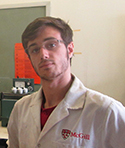 I work on Proterozoic shales, preparing them for various different geochemical analyses, including total organic carbon content, organic carbon isotopes, nitrogen isotopes, sulfur major and trace element geochemistry. The ultimate goal of this research is to understand how Earth's environment changed spanning the last 500 million years of the Precambrian.
I work on Proterozoic shales, preparing them for various different geochemical analyses, including total organic carbon content, organic carbon isotopes, nitrogen isotopes, sulfur major and trace element geochemistry. The ultimate goal of this research is to understand how Earth's environment changed spanning the last 500 million years of the Precambrian.
Benjamin Wyman
BSc/Honours student (2014), Earth and Planetary Sciences
Nickolas Dudeck
BSc/Honours student (2014), Earth and Planetary Sciences

